Are you thinking about exploring the majestic mountains of Cusco, in the Peruvian Andes? It’s normal to have doubts about which trek to choose. You’re in the right place!
The Salkantay Trek and the Ausangate Trek are two of the most popular hiking routes in Cusco, known for their breathtaking landscapes and deep connection with nature. However, each one has its own unique features.
Which route should you choose? In this blog, we’ll explain the key differences between the two so you can make an informed decision and plan the perfect adventure for your trip to Peru. Let’s get started!
Discovering the Salkantay Trek and the Ausangate Trek
Welcome to one of the most impressive destinations in the world! Cusco, the ancient capital of the Incas, is surrounded by the high mountains of the Andes, making it one of the best places for hiking in South America.
Here you can take tours to Machu Picchu, hike to Rainbow Mountain, climb to Humantay Lake… or combine it all! The Salkantay Trek and the Ausangate Trek take you to discover the best of the Peruvian Andes, with routes that combine some of the top sites in Peru. In addition, they hold special meaning for the local population.
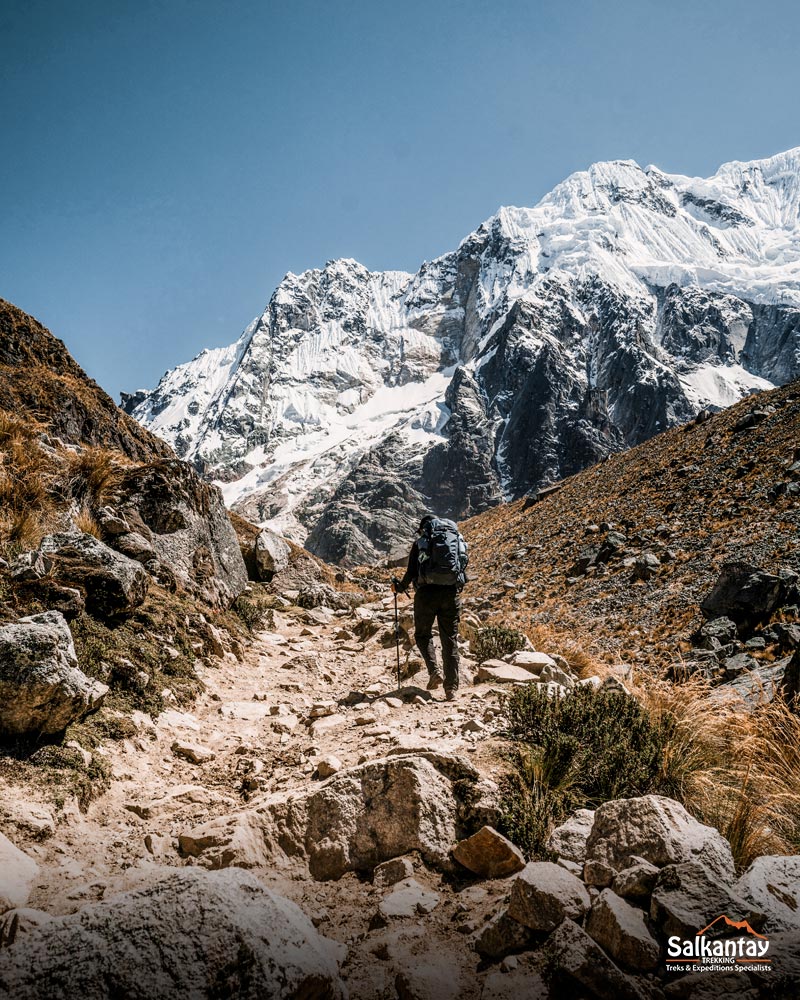

Both Salkantay Mountain and Ausangate Mountain are considered “Apus“ in the Andean worldview: sacred spirits that protect communities and nature, helping to maintain the balance of the natural world. In Cusco, the energy of these mountains is felt both in the imperial city and its surroundings.
Trekking in such a unique and energy-filled natural environment as Salkantay and Ausangate is a once-in-a-lifetime experience.
Salkantay Trek
The Salkantay Trek is one of the most fascinating hiking routes in Peru. It is an alternative route to Machu Picchu, although it has come to be recognized as one of the best hikes in the world by National Geographic magazine. It is ideal for travelers seeking adventure and diverse landscapes. In addition, it offers the possibility of sleeping in exclusive and comfortable camps, enjoying a well-deserved rest after intense days of trekking.
The classic version of the Salkantay Trek to Machu Picchu includes:
- A visit to Humantay Lake, famous for its turquoise waters.
- The ascent to the Salkantay Pass, the highest point of the route, with stunning views.
- A well-deserved rest in the Cocalmayo hot springs, perfect for relaxing.
- And, of course, the arrival at the magical citadel of Machu Picchu, one of the 7 wonders of the world.
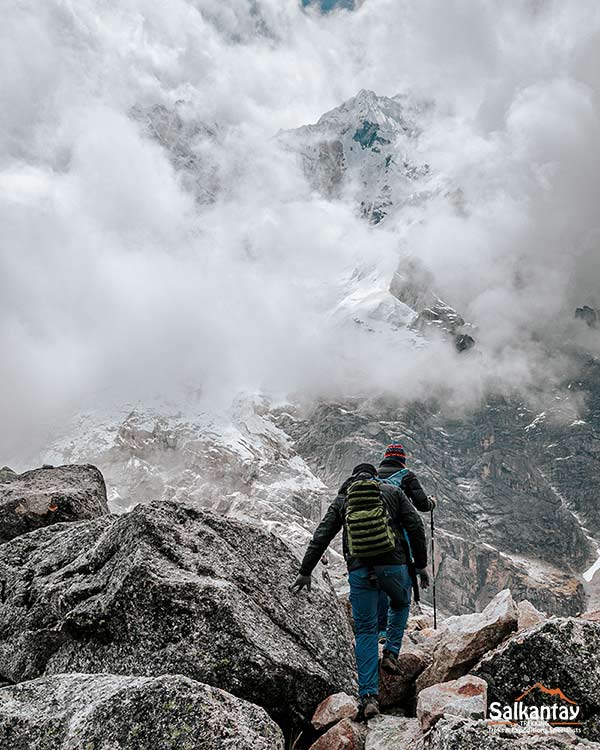
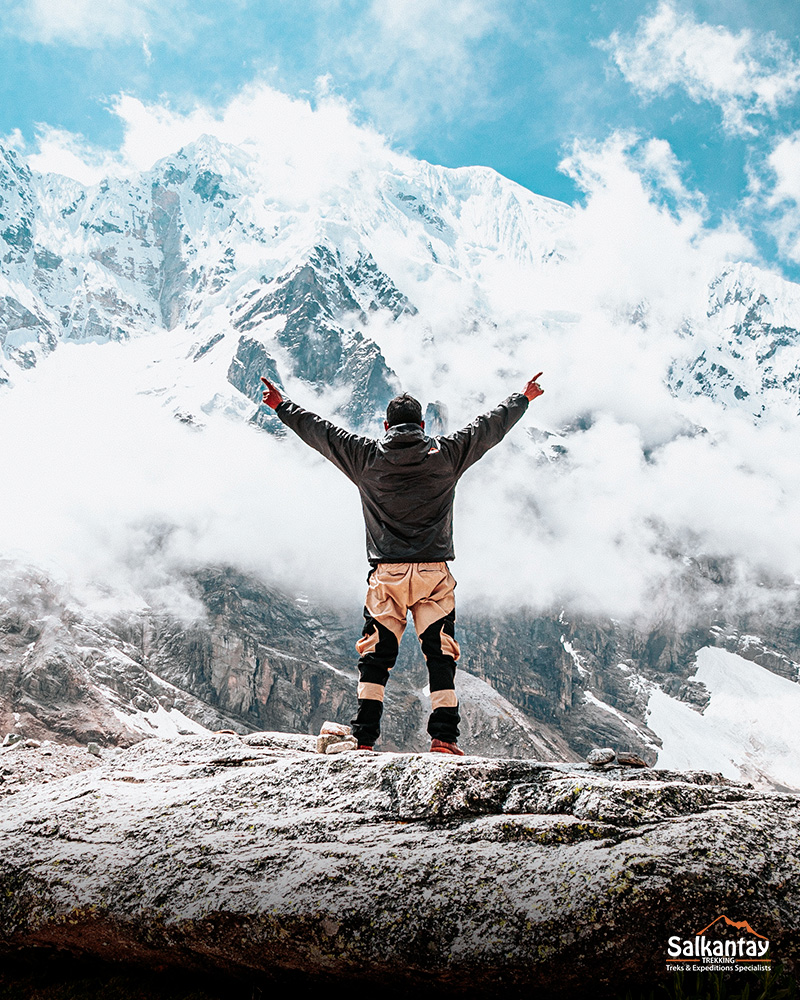
Ausangate Trek
For true hiking enthusiasts, the Ausangate Trek is a gem not to be missed. Ausangate is the fifth highest mountain in Peru (6,372 meters / 20,905 feet above sea level) in the Vilcanota mountain range. In addition to its grandeur, Ausangate is surrounded by myths and legends that make it a must-visit place in Peru.
You’ll also enjoy rewarding interactions with local villagers and learn about aspects of their culture. An experience that will exceed the highest expectations of an epic journey.
The classic version of the Ausangate Trek will show you:
- Beautiful crystal-clear lakes in turquoise and green tones, surrounded by mountains.
- Spectacular views of snow-capped peaks and deep valleys.
- The company of alpacas and llamas, part of the daily life of local communities.
- A visit to the village of Pacchanta, where you can relax in its hot springs and experience rural Andean life.
- And if you choose a variation of the route, you can visit the famous Rainbow Mountain (Vinicunca), a place every tourist wants to see on their trip to Peru.º
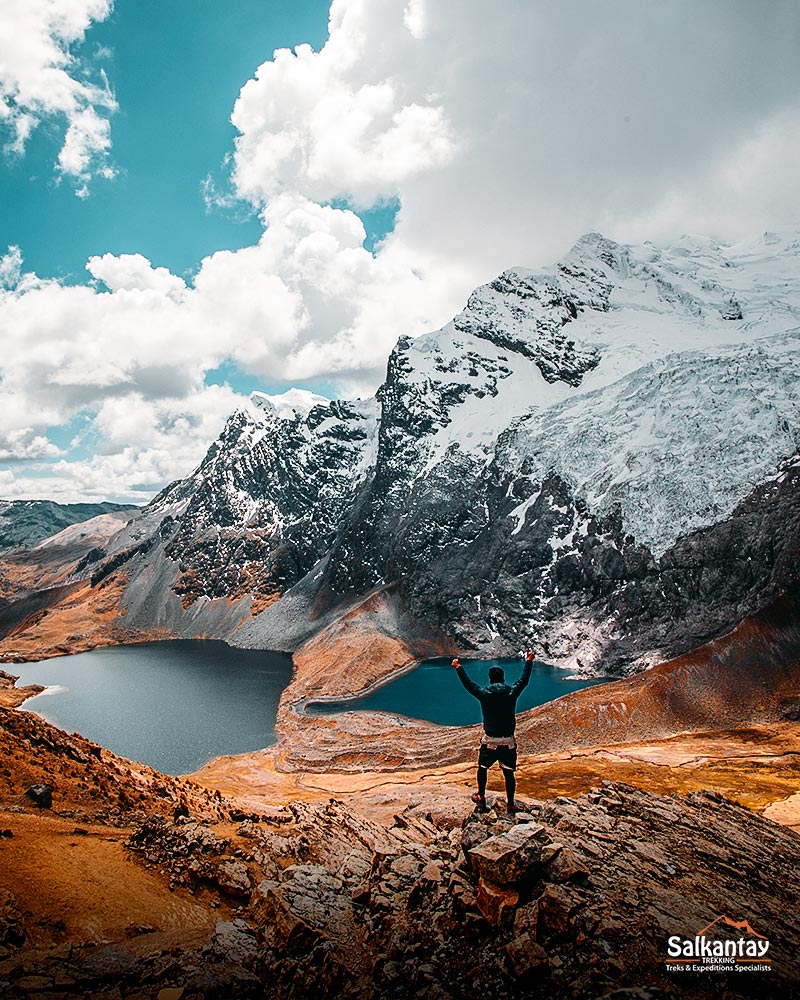
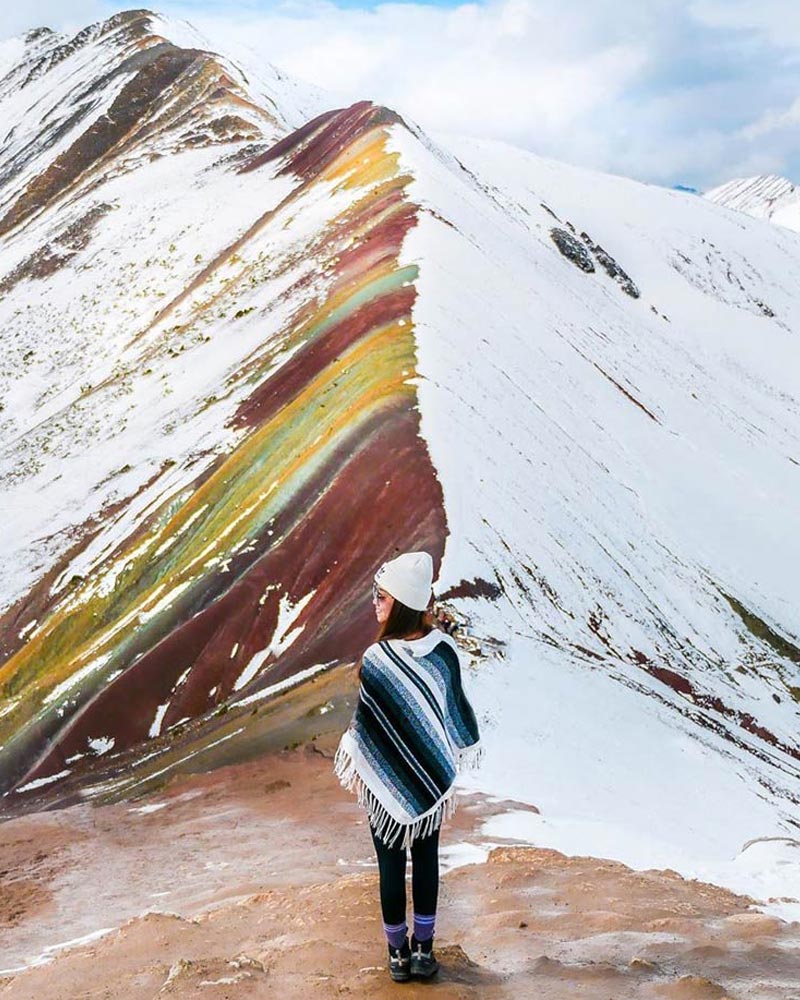
Difficulty level
How difficult is the Salkantay Trek?
The Salkantay Trek ranges from moderate to challenging difficulty, mainly due to altitude changes, rugged terrain, and shifting weather conditions. The altitude can be a challenge for some, especially if they are not acclimatized, adding to the overall difficulty of the route. The Salkantay Trek reaches high elevations, with the highest point at the Salkantay Pass at 4,630 meters / 15,190 feet above sea level.
Additionally, some sections feature uneven and rocky terrain, steep slopes, and muddy paths, which can make the trail slippery and more physically demanding.
How hard is Ausangate Trek?
The Ausangate Trek has a challenging difficulty level, though it is more demanding in terms of altitude. The Ausangate route reaches higher elevations, exceeding 5,200 meters / 17,060 feet above sea level. It takes place at higher altitudes than many other routes in Peru, requiring excellent acclimatization and good physical condition.
Another challenge on the route is the cold, especially during the frost season. In the months of June, July, and August, temperatures can drop significantly at night, even below 0 °C (32 °F). Therefore, it is essential to bring appropriate warm clothing.
Hiker’s tip: Both the Salkantay Trek and the Ausangate Trek are challenging due to the altitude, so it’s necessary to acclimate in Cusco a few days before starting the journey. You can take light tours and excursions during the first few days to explore the imperial city and get used to the altitude.
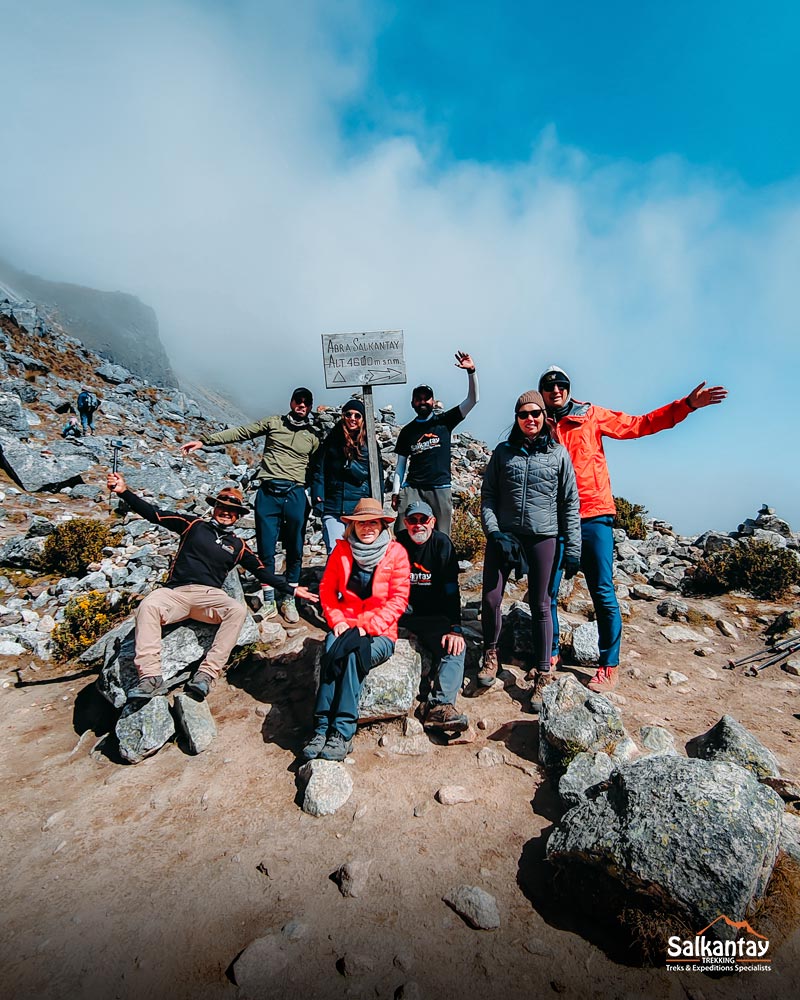
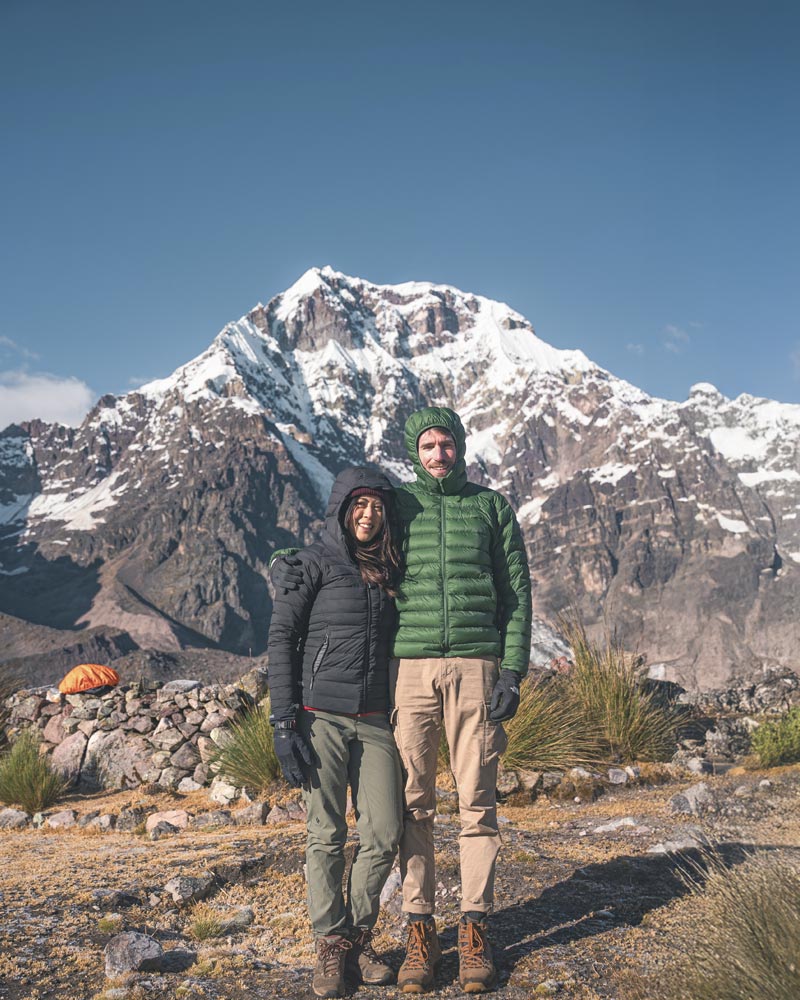
Weather
Salkantay Trek Weather
The weather on the Salkantay Trek is variable, as it passes through high mountain areas and Andean jungle zones. You must be prepared for both cold and heat.
- Temperature: The Salkantay Trek takes place in a region that ranges from high mountain altitudes to the edge of the tropical rainforest in the cloud forest. At the beginning of the trek, the weather is colder, as the Humantay and Salkantay mountains are located at higher elevations. At night, temperatures can drop below 0°C (32°F).
From the third day on, the temperature rises. In the lower areas, the weather tends to be warm during the day, with temperatures ranging between 20°C and 25°C (68°F to 77°F). - Rain: The rainy season in Salkantay is usually from November to March. During this period, rainfall is likely along the route, which can make the trails slippery and more challenging. However, the landscape will be lush and green, so it can also be a great time to enjoy the Salkantay Trek.
Ausangate Trek Weather
The weather on the Ausangate Trek is cold but stable, without too many drastic changes.
- Temperatures: The Ausangate Trek reaches even higher altitudes than Salkantay. This makes the temperatures generally colder. During the day, temperatures can range from 0°C to 15°C (32°F to 59°F) in the higher areas, but at night they can drop below 0°C (32°F). In the dry season, from May to October, the weather can be warmer during the day due to the intense sun.
- Precipitation: As in Salkantay, the rainy season in the Ausangate region generally occurs from November to March. You can expect a higher chance of rain during this period. With rain and cloudy skies, temperatures may drop. Bring warm clothing to protect yourself from the cold.
Protect yourself from the sun! Although temperatures can be cold, the sun is very intense at these high altitudes. Always use sunscreen, a hat, and sunglasses, especially during the dry season.

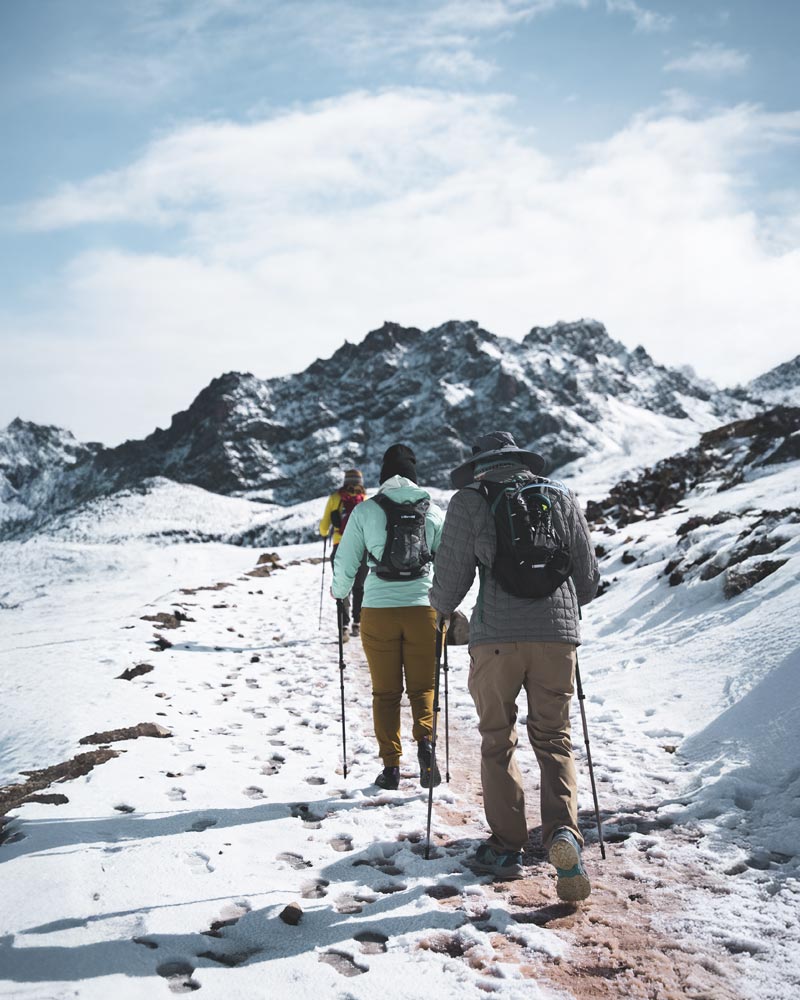
Landscapes
The Salkantay Trek takes you from the high Andes mountains to the citadel of Machu Picchu in the high jungle, offering great landscape diversity along the way.
On the other hand, the Ausangate Trek focuses on high mountain scenery, glaciers, and intensely colored lakes, and can also include the Rainbow Mountain. Both treks are truly amazing, but the choice will depend on your personal preferences:
Landscape on the Salkantay Trek:
During the Salkantay Trek, you’ll be amazed by landscapes as varied as they are breathtaking. At the start of the journey, Humantay Lake welcomes you with its turquoise waters and snowy mountain surroundings. Later, you’ll ascend to the Salkantay Pass, the highest point of the route, where you’ll enjoy spectacular views of Salkantay Mountain and its glaciers.
As you continue, the scenery changes dramatically. From the cold Andean peaks, you’ll enter a warmer, more humid environment filled with vegetation, rivers, waterfalls, and small local farms. As you approach Aguas Calientes, the town at the base of Machu Picchu, the landscape transforms into a subtropical, forested setting. You’ll have one of the best views of Machu Picchu from Llactapata, an ancient archaeological site you’ll explore on the fourth day of your classic Salkantay Trek.
You’ll pass through trails surrounded by vegetation and enjoy panoramic views of the Urubamba River, which will accompany you on your journey. Finally, you’ll feel the full energy of Machu Picchu as you explore its most important sites. You’ll also have an impressive panorama of the Machu Picchu mountains that surround the citadel.
Contemplate Machu Picchu from above. Once inside the citadel, you can choose to climb the Machu Picchu mountains for a panoramic view of the site and its surroundings. Remember to book in advance! There are limited spots and high demand.
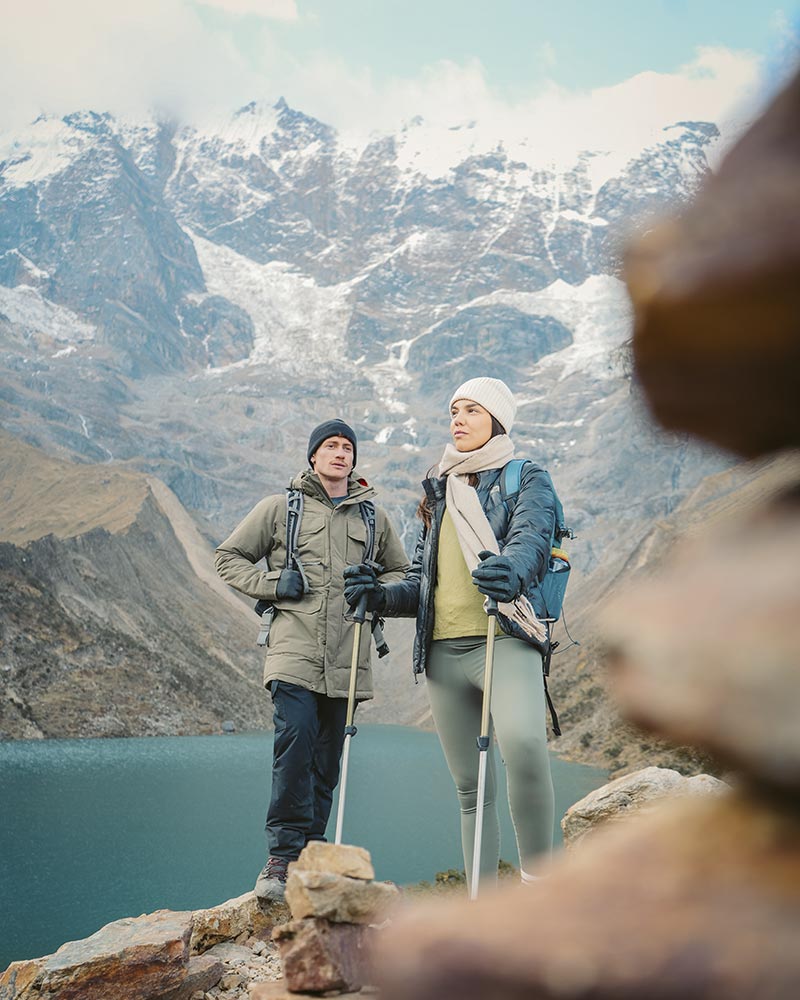
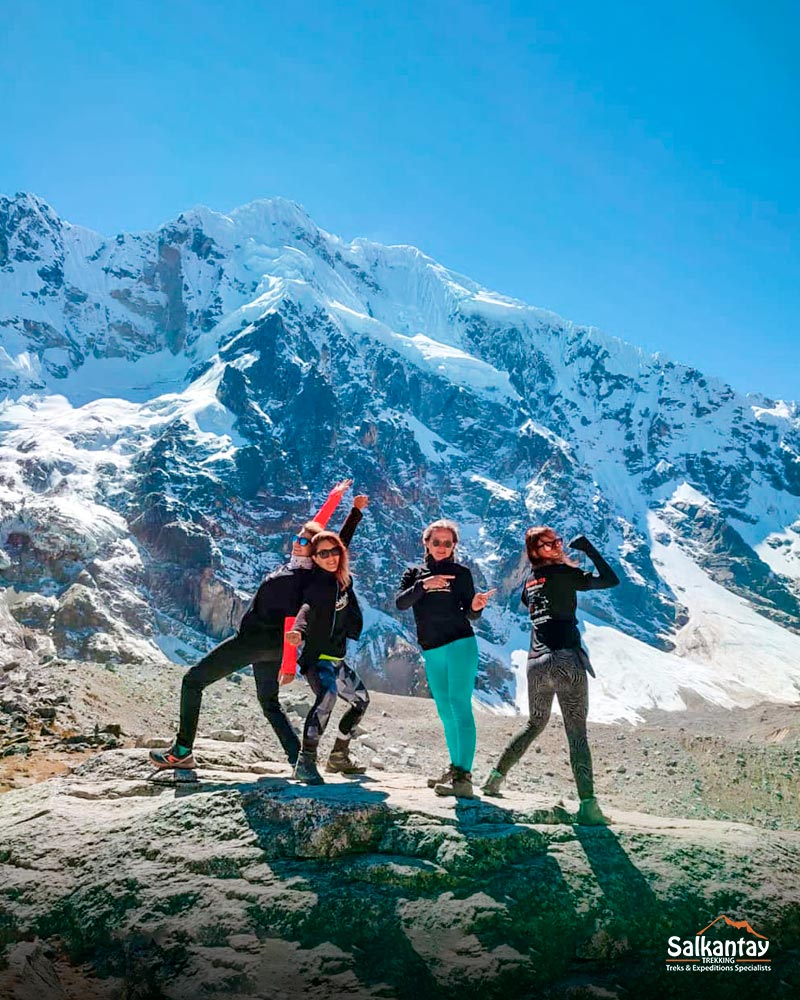
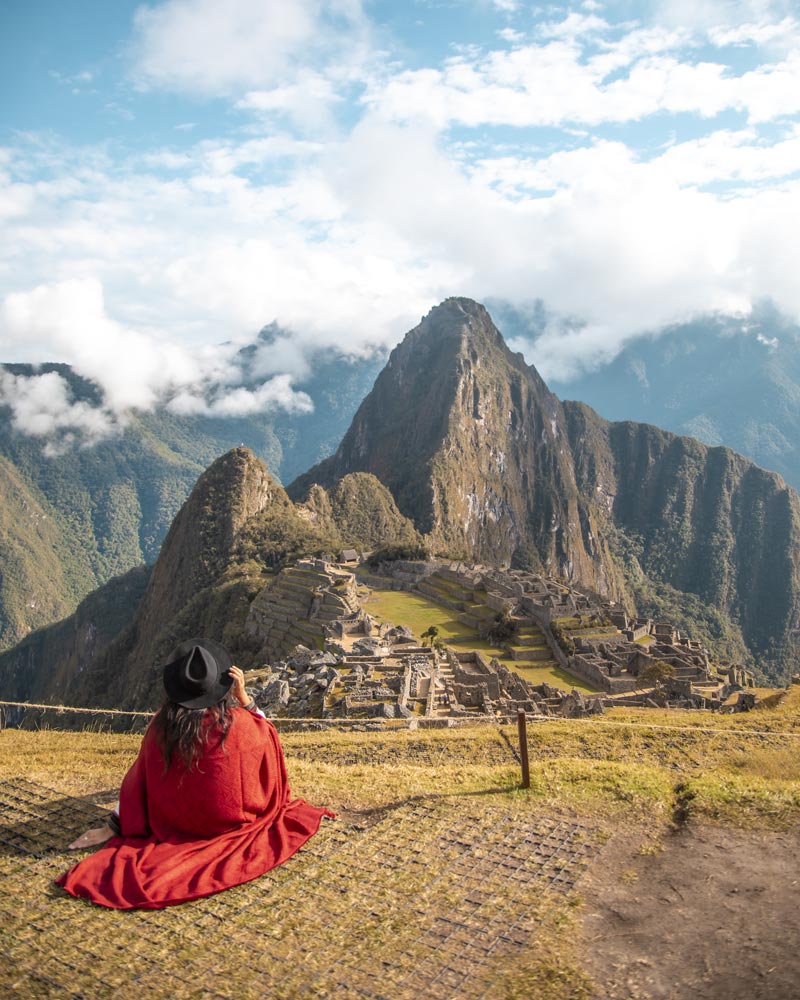
Landscape on the Ausangate Trek:
The Ausangate Trek takes place near Ausangate Mountain and offers spectacular views of the glaciers, peaks, and snow-capped mountains of the Peruvian Andes. The landscape you’ll see here from the very beginning is more alpine and high-mountain in nature.
During the Ausangate Trek, you’ll immerse yourself in otherworldly scenery. You’ll pass by intensely colored lagoons, such as Ausangatecocha Lake and the impressive Sibinacocha Lake—one of the largest in the range—surrounded by mountains. Along the way, you’ll see towering glaciers, deep valleys, stunning rock formations, and terrain rich in natural minerals that fill the landscape with reddish, green, and ochre tones.
You’ll also cross mountain passes with panoramic views. Throughout the journey, you’ll share moments with local communities, learn about their traditional way of life, and see llamas and alpacas grazing freely. Without a doubt, it is a unique visual, cultural, and spiritual experience in one of the most authentic corners of the Peruvian Andes.

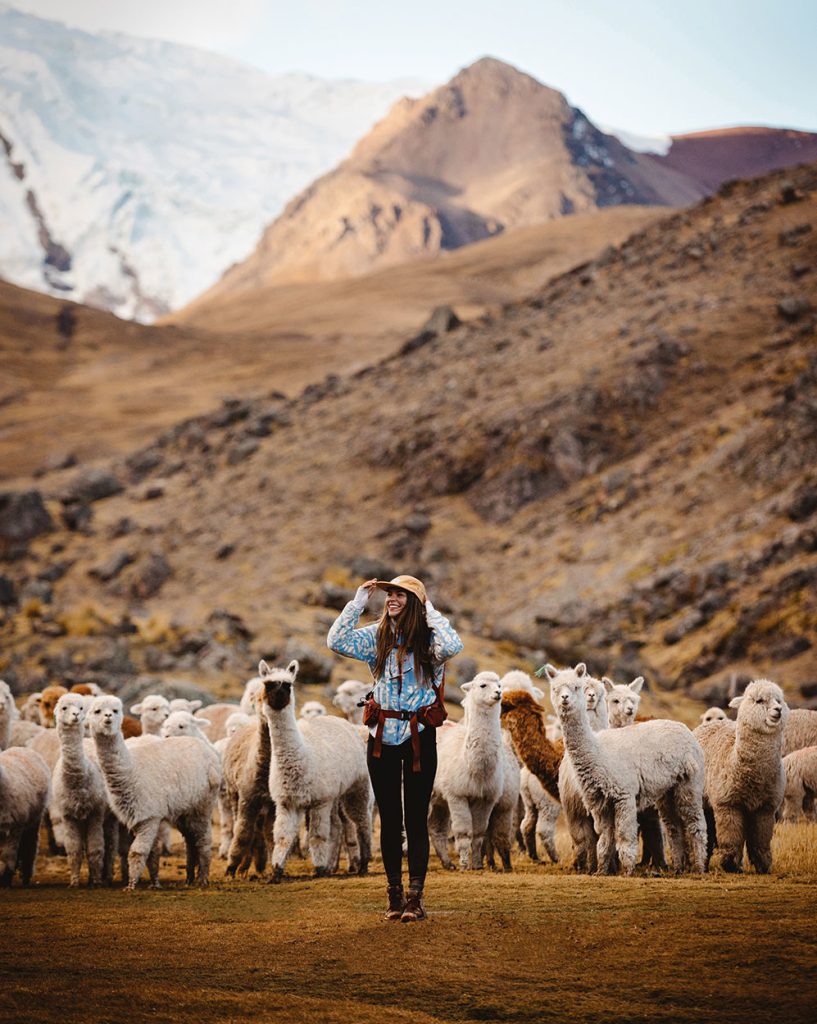

Distance
Salkantay Trek Distance
The distance of the classic Salkantay Trek is approximately 78 kilometers / 48.5 miles, completed in 5 days. The route may vary slightly depending on the agency and itinerary you choose. At Salkantay Trekking, we offer different Salkantay trek options of various lengths, with shorter and longer alternatives to suit all types of travelers.
- Humantay & Salkantay – 2 days: Visit Humantay Lake and hike at the foot of the Salkantay glacier. Distance: 26 km / 16.2 miles.
- Salkantay Trek – 3 days: Cross the Salkantay Pass and descend through the jungle toward Machu Picchu. Distance: 52.5 km / 32.6 miles.
- Salkantay Trek – 4 days: A full adventure from the mountains to the jungle, reaching Aguas Calientes and visiting Machu Picchu. Distance: 62.5 km / 38.8 miles.
- Salkantay + Inca Trail – 6 or 7 days: The best of the Salkantay route combined with the historic Inca Trail to Machu Picchu. Distance: 93 km / 57.8 miles (6 days), and 69 km / 42.9 miles (7 days).
We could say that the Salkantay trek is longer than the Ausangate trek. However, despite the greater distance, the altitude on the Ausangate route plays a key role in its difficulty and walking pace.
Ausangate Trek Distance
The distance of the classic Ausangate Trek is 55.5 kilometers / 34.5 miles, completed in 5 days. Just like the Salkantay trek, there are several route variations for the Ausangate trek. In general, trekking routes in the Ausangate area can vary in length, but a typical itinerary covers around 60 to 70 kilometers over several days.
- Rainbow Mountain & Red Valley – 2 days: Hike to the Rainbow Mountain and Red Valley with views of Ausangate. Distance: 18 km / 11.2 miles.
- Ausangate & Rainbow Mountain – 3 days: Discover beautiful lagoons near Ausangate Mountain and reach Rainbow Mountain. Distance: 33.5 km / 20.8 miles.
- Ausangate & Rainbow Mountain – 4 days: A full adventure through turquoise lagoons, snow-capped peaks, and Vinicunca, the Rainbow Mountain. Distance: 37.5 km / 23.3 miles.
- Ausangate & Sibinacocha Lagoon – 7 days: Huge lakes, high mountain passes, and a unique cultural experience. Distance: 79 km / 49.1 miles.
Get ready for the trek! Make sure you’re in good physical shape for several days of hiking. You can train at gyms in Cusco, which have the necessary equipment to help you prepare properly.
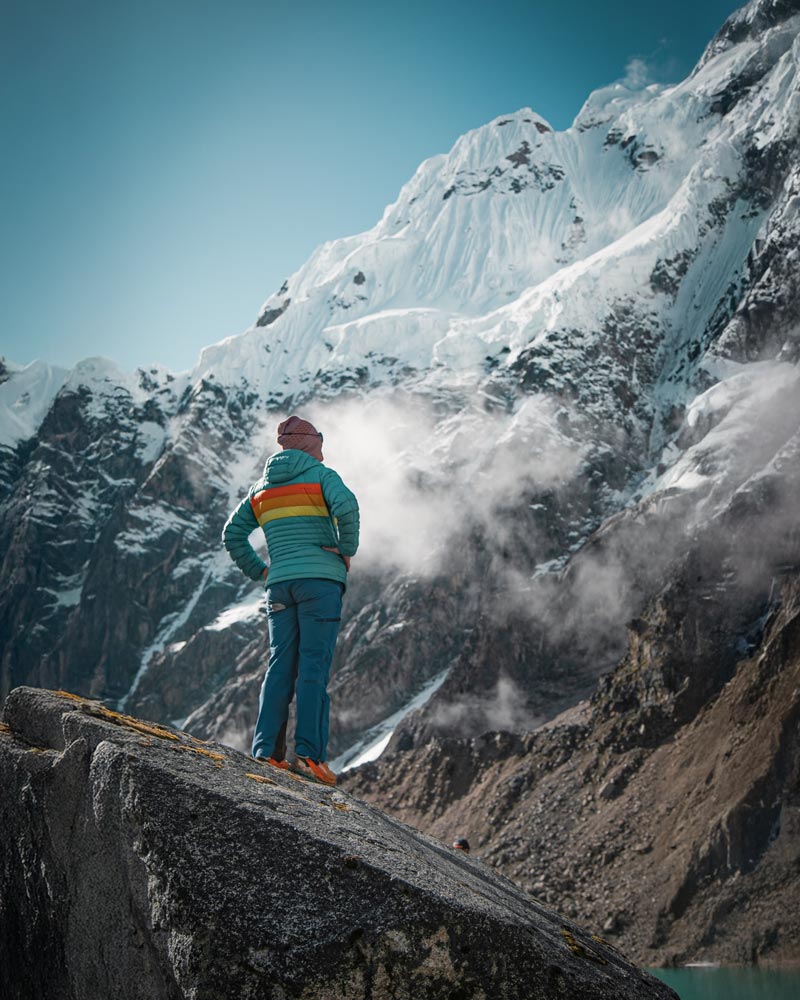
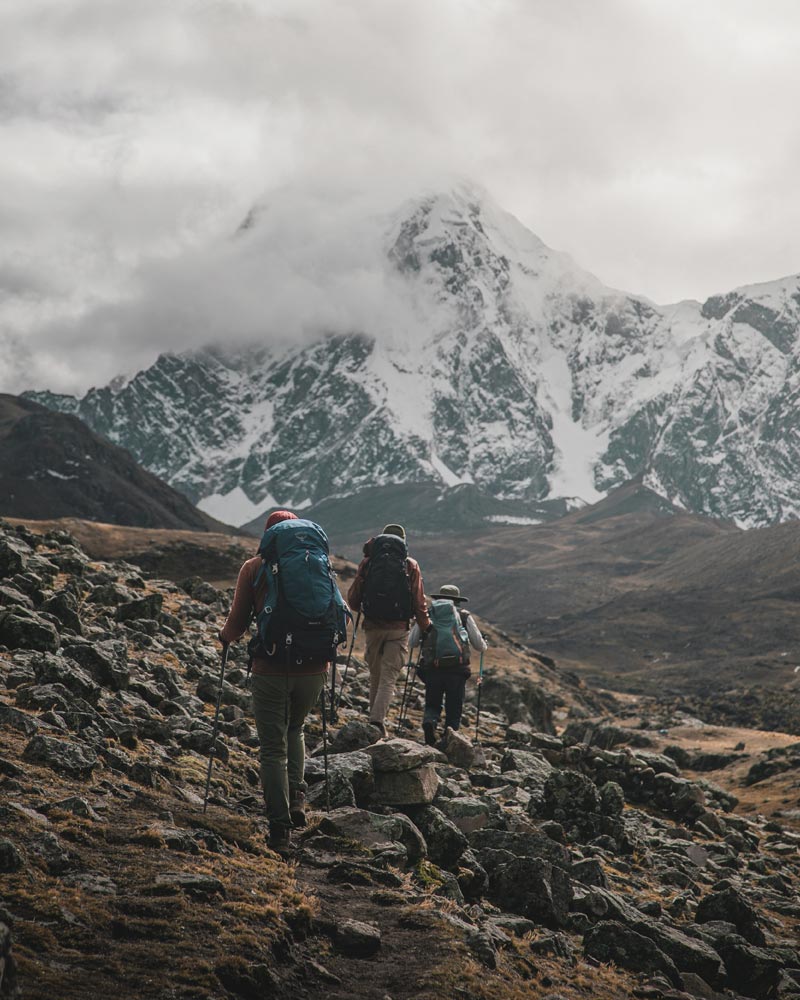
Crowds
The Salkantay Trek to Machu Picchu is one of the popular routes to reach the inca citadel, so you can expect to encounter more hikers on the trail, though fewer than the globally renowned Inca Trail.
In contrast, the Ausangate trek is less traveled, offering a quieter and more secluded experience in nature.
Camps
Where to Sleep on the Salkantay Trek?
At Salkantay Trekking, you’ll have the chance to spend your nights in our exclusive campssites: Sky Camp in Soraypampa, Mountain Sky View in Collpapampa, Super Jungle Domes in Lucmabamba, and a comfortable hotel in Aguas Calientes, before reaching the majestic Machu Picchu.
Our accommodations offer electricity, Wi-Fi, and plentiful meals tailored to your needs. Starting on the second day, you’ll enjoy a room with a private bathroom and hot shower, so you can rest in total comfort. Sleeping in the heart of nature has never been so pleasant!

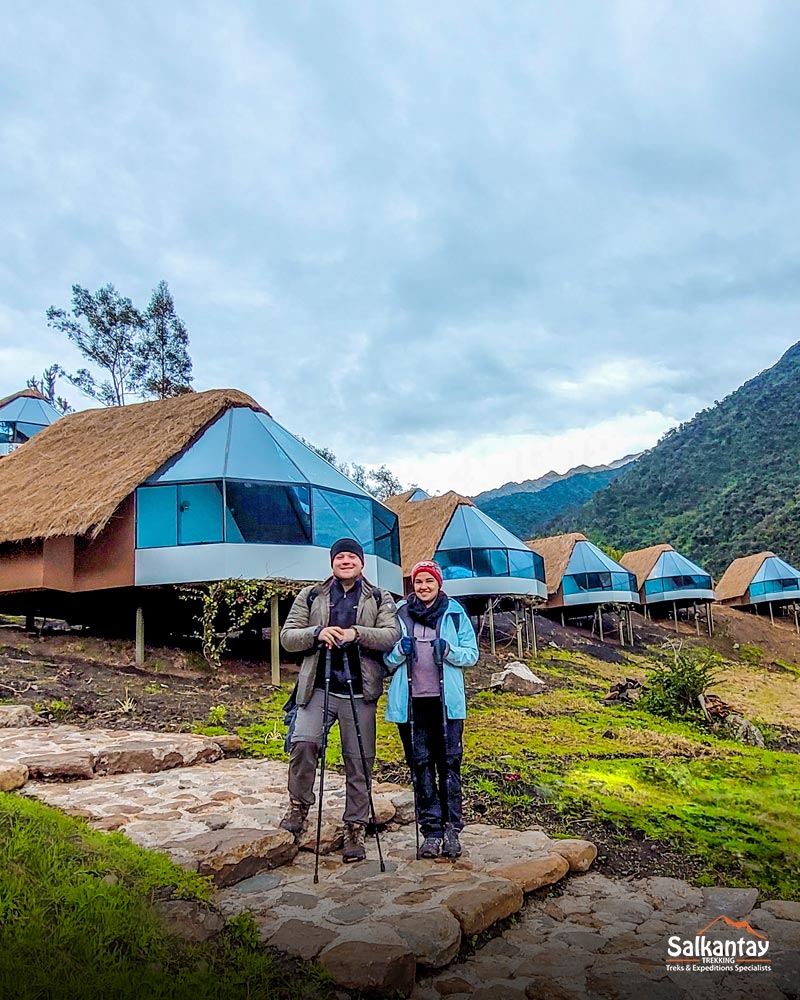
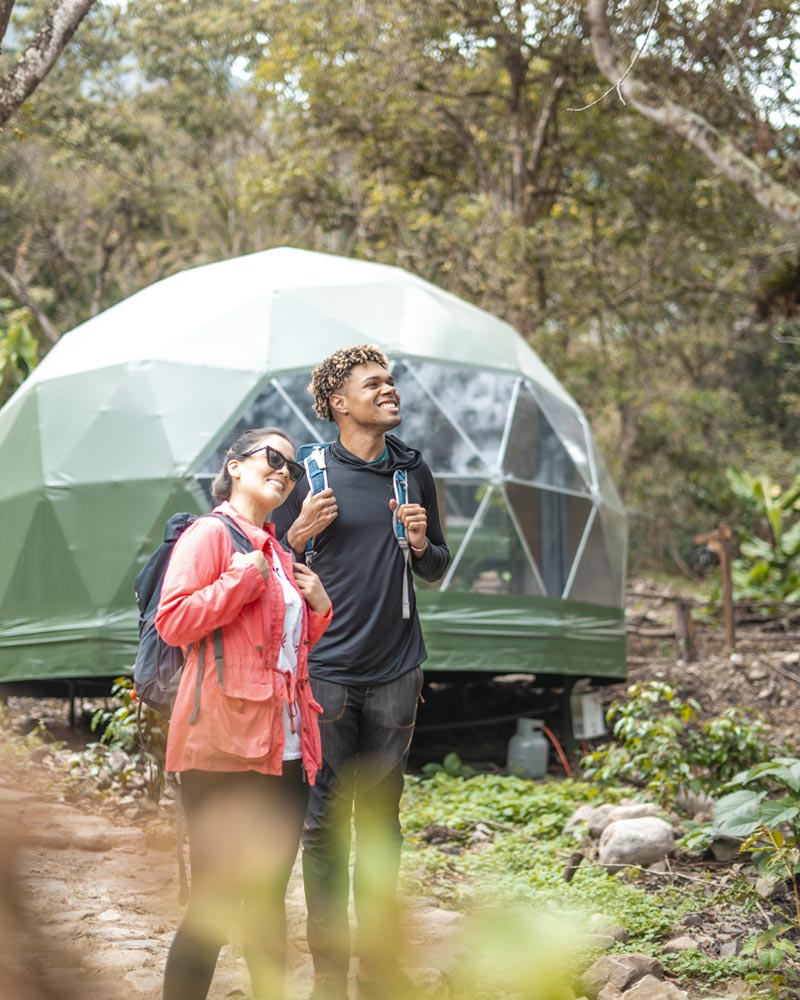
Where to Sleep on the Ausangate Trek?
Unlike the Salkantay trek, on the Ausangate trek, you’ll sleep in comfortable and cozy tents, enjoying nature and appreciating the Peruvian Andes. Accommodation infrastructure is more limited than other routes like Salkantay or the Inca Trail. That said, you must be prepared for rustic conditions and changing weather. But don’t worry — we’ll provide all the necessary camping equipment so you can sleep warm and comfortably throughout the entire trek.
What gear do we use at our campsites? Watch our video about the equipment used on the routes in Cusco to see what’s waiting for you.


Which route should you choose, Salkantay or Ausangate?
We’ve created a comparison table so you can see the main differences between the two classic routes and decide which one is ideal for you.
| Trail | Salkantay Trek | Ausangate Trek |
|---|---|---|
| Maximum altitude | 4,630 m/15,190 feet | 5,200 m/ 17,060 feet |
| Trek distance | 78 km/48,5 miles in 5 days | 55,5 km/34,5 miles in 5 days |
| Difficulty level | Moderate to Challenging | Challenging |
| Accessibility and Comfort | More accessible and suitable for various ages. Exclusive accommodations with all the comforts. | Preferably for travelers with experience in hiking and high altitudes. High-quality camping equipment ensures a great experience in the Andes. |
| Altitude sickness | Lower risk of altitude sickness | Higher risk of altitude sickness |
| Number of visitors | Many, especially during high season (May–October) | Few |
| General experience | Ideal for a different kind of experience, with breathtaking views and the serenity that only mountain solitude can offer. Perfect for photography and nature lovers. | Ideal for a peaceful experience, with numerous attractions to discover and an easy hike. Perfect for families and older adults, with no major physical demands. |
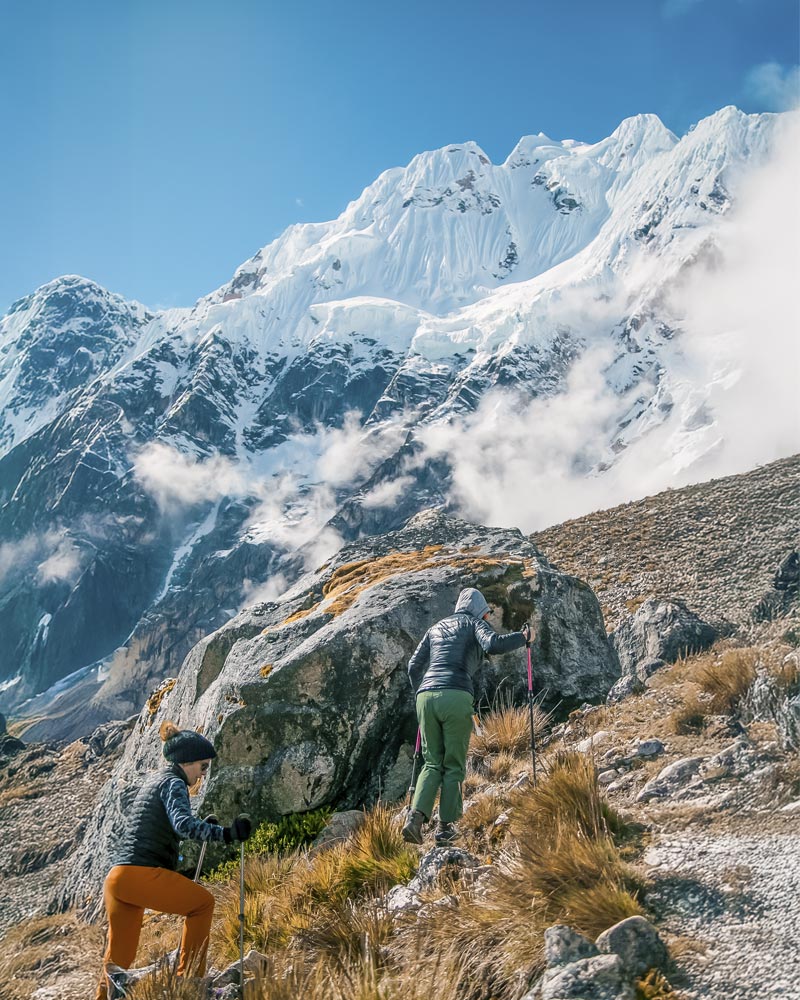
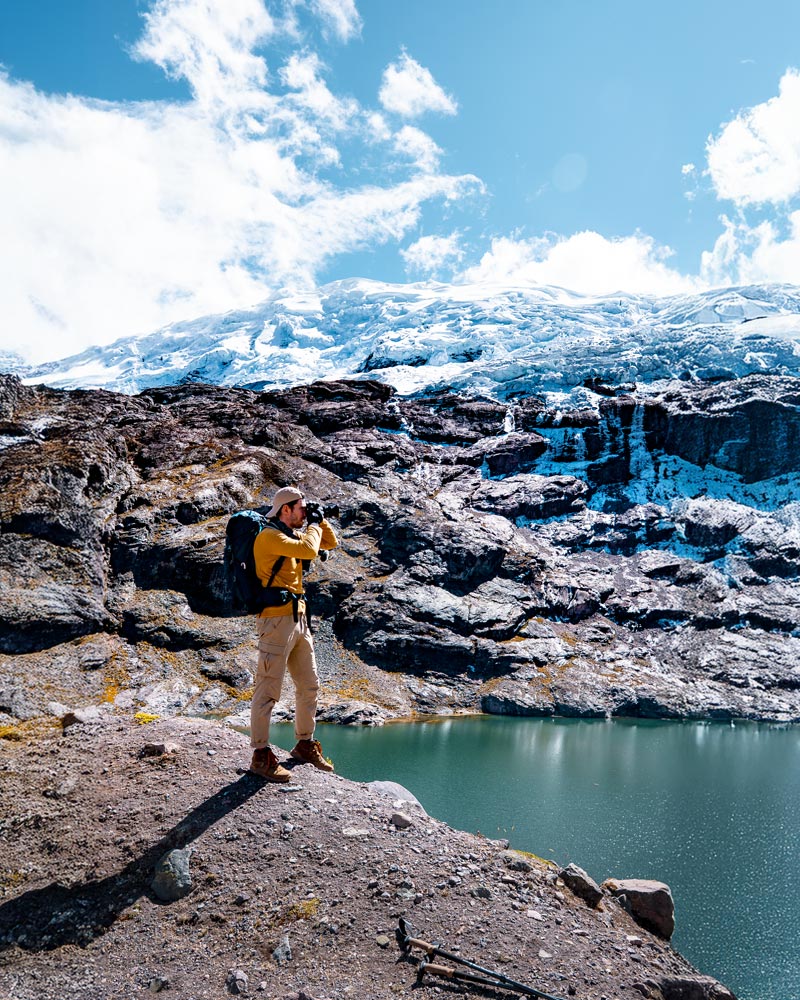
The choice between these two adventures through Peru’s majestic sacred mountains depends on your preferences, physical fitness level, and what you desire to experience in your journey through Peruvian nature.
If you seek a gradual immersion into the world of Andean trekking and wish to experience a variety of landscapes, the Salkantay trek in Peru is an excellent choice. On the other hand, if you are looking for a more extreme challenge and desire a high-mountain environment, the Ausangate trek is the right choice.
Whichever you choose, with Salkantay Trekking, you can be sure of trek in Peru and having an unforgettable experience in the Peruvian Andes.
You Might Be Interested In
- Adventure at Altitude! How to Train to Fully Enjoy Trekking in Peru
- Ausangate and Community Tourism
- Rainbow Mountain, Vinicunca 2025: Everything You Need to Know
- Discover Cusco’s Red Valley and feel like you’re on another planet
- The Ultimate Travel Guide to Machu Picchu
- Trip to Cusco: How to Organize the Perfect Itinerary
- Salkantay Trekking: Tourism in Constant Growth

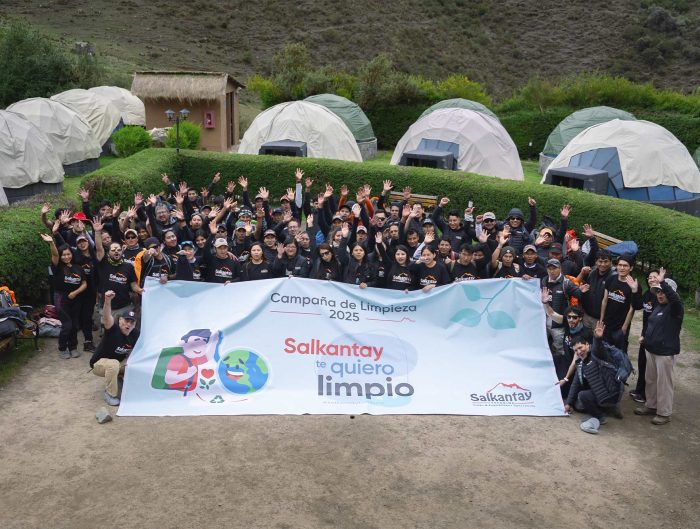
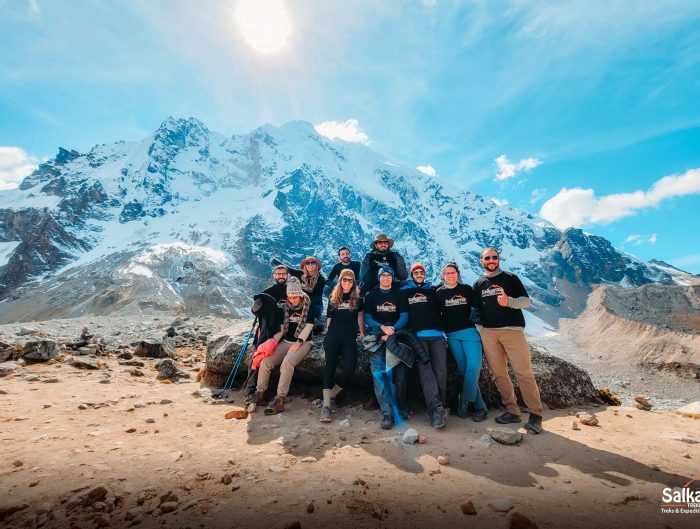

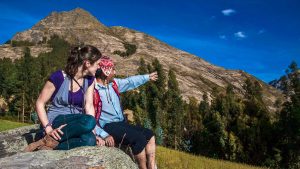
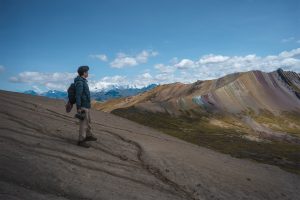
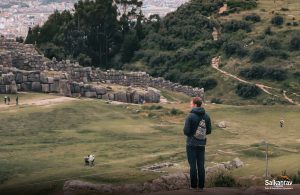
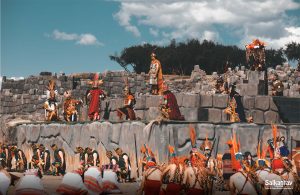



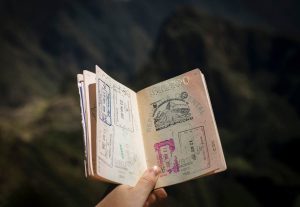
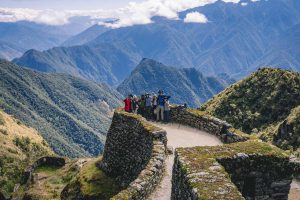

Leave A Reply